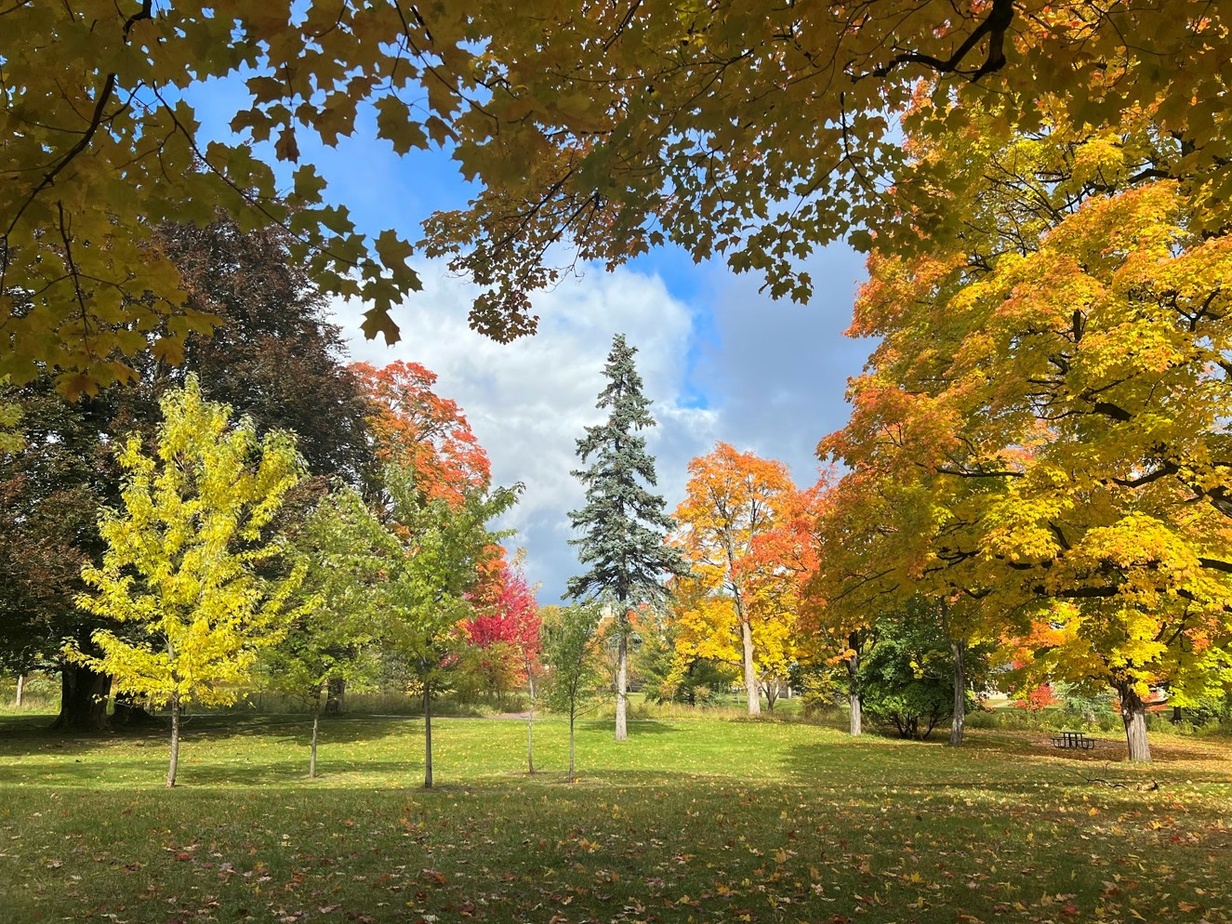
New Nonprofit Working To Protect Historic Arboretum At The Commons
By Ross Boissoneau | July 6, 2025
While the buildings have been brought back to life at the Village at Grand Traverse Commons, another historic part of the site is in need of attention. The Historic Arboretum was originally planted under the direction of Dr. James Decker Munson, founder of the Northern Michigan Asylum. He sought to extend the then-nascent “Beauty is therapy” doctrine beyond the buildings to include the grounds.
By the time Munson arrived, the site had been clear-cut by the lumber industry, and he was greeted by the sight of fields of stumps. He put the male patients to work removing them. On his travels throughout the nation, he came across many different species of trees and sent seeds or seedlings back home. They included pyramidal English oaks, copper beech, yellowwood, elm, horse chestnut, pecan, sweetgum and gingko biloba.
“It shows how special this place was, how loved this place was,” says Matthew Ross. “They were invested in the site.”
So too is Ross. The Executive Director of The Botanic Garden at Historic Barns Park is one of the members of the Friends of the Historic Commons. The non-profit has two main projects: preserving the history and cultural significance of the hospital and its grounds, and preserving and restoring the Historic Arboretum.
The latter is no small task, in part because of the changes in the landscape and climate, but largely because the property was abandoned for decades. As a result, the historic trees Munson and his team planted were simply ignored for years and years. Many fell victim to disease, insects and nature’s whims.
Even today, the remaining trees are at the mercy of nature. A recent storm took down one of the largest and most historic ones. “We lost in the wind one of our very significant trees, a sugar maple,” says Winnie Simpson, another member of the Friends board. “At one point, there was an entire line of sugar maples (at the entrance to the grounds). Very few are left.”
Ross says tours of the property help people understand the beauty and significance of the arboretum. Now people can do self-guided tours and learn about the trees as they observe them. In 2021, with the help of Davey Tree Service, 465 Trees within the Historic Arboretum at the Grand Traverse Commons were catalogued.
The following year the organization commissioned Schillinger Forestry to undertake a more extensive tree-by-tree survey. When completed in 2023, it provided greater detail about each tree’s health and specific recommendations for its future maintenance. Each is now geotagged, so people can use their smartphones or tablets to identify the tree as they observe it.
Not all the trees can be saved, and restoring the arboretum isn’t simply a matter of replanting the same kind of trees as were there before, or restoring the original layout. The hope is to reflect the present day as well as what was there in 1885, making clear what is old and what is new.
“We’re blessed to have some of the historical trees planted by (Munson), the patients and gardeners,” says Ross. “Trees have a finite life. Many of them are in need of some TLC.” That could include removing dead limbs, structural pruning, combating soil compaction by removing grass and adding mulch, even deep root feeding.
Ross, Simpson and the rest of the board are working with professional arborists to assess the health of the remaining trees and plan next steps. “We’re still a relatively new non-profit. We’re working on our goals and vision,” says Ross. “It’s going to take a long time.”
The group’s website lists three items as next steps: Establish a Tree Fund to assist property owners to maintain or replace trees; help property owners identify and maintain important trees; and raise funds to put signage on each individual tree to identify the type of tree and, if appropriate, why it is historically or botanically important.
The grounds are actually owned by several different entities, including the Village Condominium Association, Women’s Resource Center, the Pavilions, and the Minervini Group. The Friends say all the landowners are supportive of the project, but working with so many property owners makes it more challenging.
The average lifespan of a tree can range from 30 years to hundreds of years, depending on the species. Ross and Simpson say some of the trees onsite are nearing the end of their lives. Diseases, insects, storms and climate change are exacerbating the challenge.
Simpson says the first order of business is addressing the health of the trees already there, though “maintenance isn’t sexy,” she admits.
Replanting presents another series of challenges. “It goes to the question of what to plant,” says Simpson. Sometimes it could be the same species, other times perhaps not.
One hope is they can propagate clones of some of the most significant trees, preserving the genetic heritage if not the exact same tree. “It’s a museum of trees, it tells a story,” says Ross. “My personal vision is to see them propagated. A clone carries with it the history of the site.”
Simpson concurs. “I like to think the arboretum is the living history of the state hospital,” she says.
Comment






